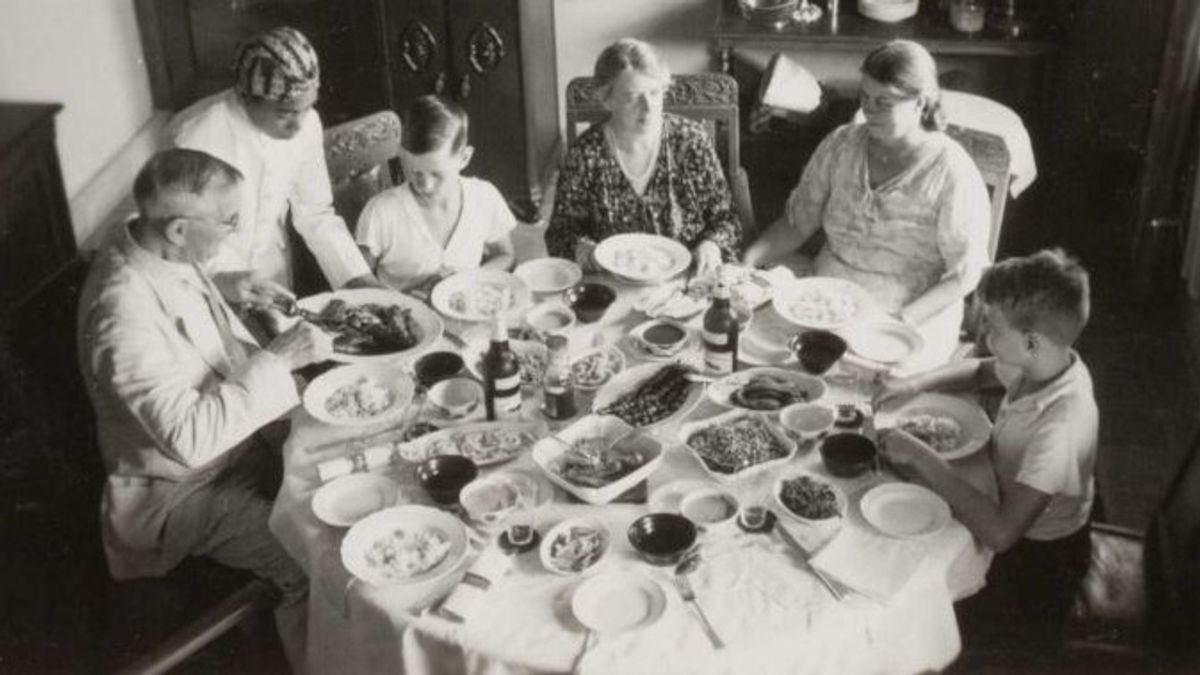JAKARTA - Indonesia is not only rich in types of culinary delights from various regions, but also has a variety of ways of serving. One of them is rijsttafel or Rice Table which means rice table. This method of presentation was popular in the Dutch East Indies (Indonesia) colonial era.
Basically, Rijsttafel is a concept of banquets or serving a complete European-style meal. Where in this eating procession begins with an appetizer then the main menu and ends with a dessert.
The food served is typical of the archipelago, but wrapped in European style. Well, the emphasis is on how to serve this food. But unfortunately, this term is now starting to disappear. Even stranger is heard by the public today.
The presence of rijsttaffel at that time was quite special and luxurious. Because, among the many histories during the Dutch colonial period, rijsttafel can be a differentiator, in which at that time the fusion of culinary cultures of the archipelago and the Netherlands can be harmoniously united on the dining table.
The serving of rijsttafel is usually done at lunch time on Sundays. However, not all Dutch families can bring the luxury of rijsttafel into their home. It was calculated that only those who were truly wealthy could only present the Rijsttafel celebration. This dish can be a measure of a person's wealth.
Therefore, it was the Company officials and the aristocrats who made this culinary culture sustainable. In fact, to this day rijsttafel is increasingly popular served in luxury restaurants in the Netherlands Windmill Country.
According to Djoko Soekiman in the book Indis Culture From the Company Age to the Revolution (2011), the diversity of menus and the number of servants involved in the rijsttafel celebration made this momentum a means of showing social class.
“Many Dutch families, especially children who have lived or came from Indonesia, serve the Indische Rijttafel menu. This dish consists of soto rice, fried rice, rames rice, gado-gado, spring rolls and so on. "
Not surprisingly, in colonial times the momentum of the rijsttafel celebration was used by many Dutch people to invite important guests to their homes. This was allegedly a strategy so that people who came could know how rich the owner of the house was. Hella S. Haasse wrote a similar experience in his book Sang Juragan Teh (1992).
In a book containing a biography of the pioneer of Indonesian tea development Robert Eduard Kerkhoven (1848-1918), Hella wrote that Robert, who for the first time set foot in the colony, was happy when he was greeted by his parents' family with a sumptuous dish of rijsttafel.
Therefore, it was at that moment that Robert understood that through the celebration of the meeting, all important matters could be resolved without a complicated process.
"On the appointed day, his children who live in Batavia gather there, discussing family problems while eating rijsttafel. Having lived in the city for a long time and knew everyone well, he (Robert's uncle) was able to realize the relationship by negotiating only by means of an informal letter or through private conversation (during the rijsttafel celebration), and thus, the convoluted transaction process. entanglement can be avoided, ”wrote Hella.
The origin of RijstaffelThe Rijstaffel culture clearly did not exist by itself. As explained by Fadly Rahman in the book Rijsttafel: Culinary Culture in Colonial Indonesia, 1870-1942 (2016), rijsttafel is the result of a combination of Indonesian and Dutch culture which is often referred to as Indis Culture.
The combination was based on the large number of Dutch soldiers and officials who proposed to wives from the natives because of the absence of Dutch women in the Dutch East Indies. In the future, this marriage path will also produce a variety of cultural products, ranging from buildings with Indische style nuances, tanjidor music, dutch wife (bolster pillow), to rijsttafel.
However, the term only became popular in the Dutch East Indies around the 1870s. At that time, many Dutch people began to arrive from the colonies thanks to the opening of the Suez Canal. Long story short, the Dutch, who were a little shocked by the tropical climate, began to adjust. One way, they have to adjust to food problems.
For the rest, fadly quoted historian Ong Hok Ham who revealed that the origin of rijsttafel was closely related to the luxury of eating habits in Javanese palaces in the past. "The luxury in the dishes and services of rijsttafel at a glance has similarities to the traditions and eating habits of the palaces."
This opinion is quite reasonable. From the available data, the VOC Dutch Trade Association Ambassador Rijklofs van Goens visited the Mataram Palace in 1656.There, he seemed confused to see so many types of food served in welcoming guests, ranging from meat, chicken, fish, to vegetables processed from starting to be burned, fried, until steamed.
However, there are also other opinions which emphasize that this culture emerged, precisely from the welcoming guests in the style of European landlords in Java. "The closest inspiration to rijsttafel actually stems more from the luxurious dining rooms of plantation landlords in Central and East Java in the late 19th to early 20th centuries," said Fadly.
During its development, rijsttafel was originally served only, then began to be served outside the home. A newspaper published by Batavia in 1868 ran an advertisement looking for a cook who could make rijsttafel at the Cavadino Restaurant, Batavia.
"The advertisement shows that the rijsttafel dish can be enjoyed outside the home, namely the restaurant. Apart from the restaurant, rijsttafel, considered a shocking dish for these newcomers, can be enjoyed in hotels or inns. Then there is a habit that is recommended to be done after enjoying the rijsttafel, namely siesta or taking a nap, "said Achmad Sunjayadi in the book Tourism in the Dutch East Indies 1891-1942 (2019).
In line with that, rijsttafel later became a symbol of lifestyle among the Dutch who adopted the habit of eating rice as a form of colonial culture. Uniquely, through this rijsttafel, local dishes have gained popularity and are famous throughout the country.
Not only that, the evidence of his daily life was also sung by the Surabaya-born Dutch singer Wieteke van Dort through a song entitled Geef Mij Maar Nasi Goreng (1991). The song comes as a manifestation of how much longing and influence Indonesian culinary has for those who have lived in the Dutch East Indies. nuances of longing can be traced through the lyrics:
Toen wij repatrieerden uit de gordel van smaragd
(When we left the Emerald Land of Indonesia)
Dat Nederland zo koud was hadden wij toch nooit gedacht
(It was totally unexpected that the Netherlands was so cold)
Maar 't ergste wasn't ethene. Nog erger and op reis
(But what's outrageous is the food, really lousy)
Aardapp'len, vlees en groenten en suiker op de rijst
(Potatoes, meat and vegetables, and sugar with rice)
Geef mij maar fried rice met een gebakken ei
(Give me fried rice with fried egg)
Wat sambal en wat kroepoek en een goed glas bier erbij
(With chilli and crackers and a glass of the best beer).
The English, Chinese, Japanese, Arabic, and French versions are automatically generated by the AI. So there may still be inaccuracies in translating, please always see Indonesian as our main language. (system supported by DigitalSiber.id)









